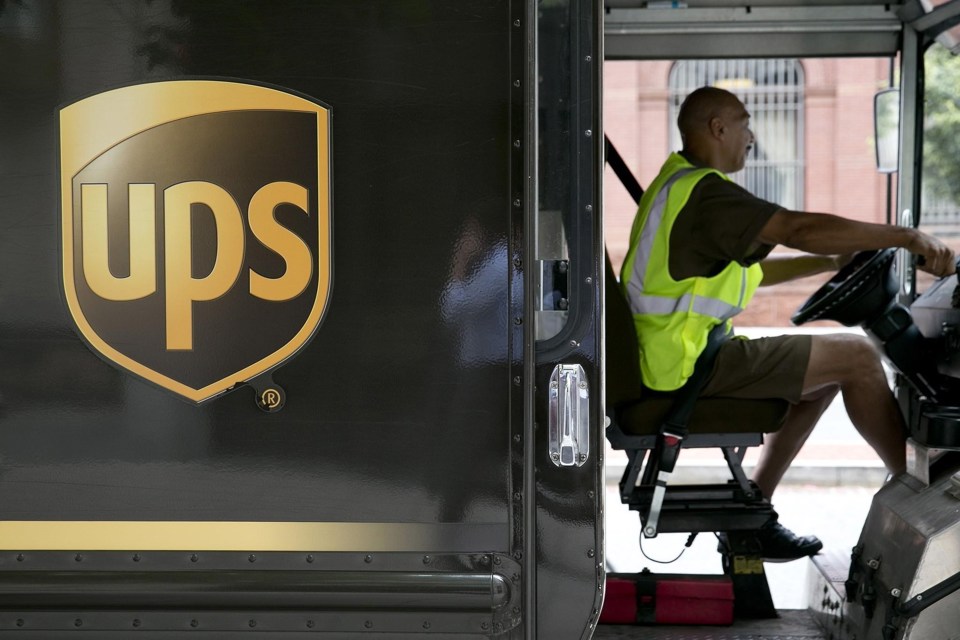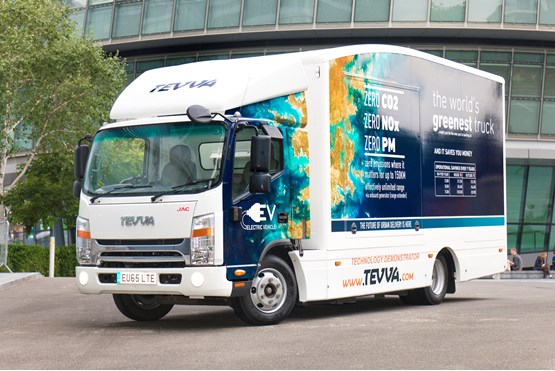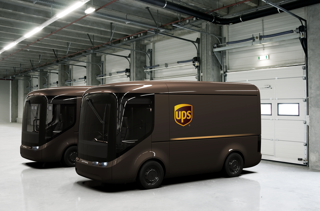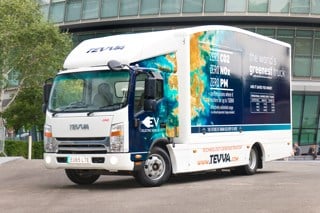Logistics and transportation business UPS has taken another step towards an electric fleet with the introduction of 15 Tevva range-extender 7.5-tonne trucks.
The company, which already operates 100 electric vehicles in the UK, typically in the 3.5-to-7.5-tonne range, has been working with Tevva on prototypes for several years, according to Luke Wake, UPS International’s director of automotive engineering & advanced technology.
“We developed a proof of concept three years ago to prove that the technology can work,” Wake said. “We operated it for six-to-12 months and saw areas where the product could be improved, refined and re-engineered. Tevva has been refining it and now it has led to the deployment of 15 vehicles, 10 at our Tamworth depot and five in Southampton.”
The vehicles were part-funded by the Office for Low Emission Vehicles (OLEV) and Innovate UK. They feature new hybrid electric vehicle technology, which increases route range while maintaining the cargo capacity (23m³) of traditional diesel vehicles of the same weight class.
“Previously, this weight class has been restricted to 75km (approx 47 miles),” said Wake. “But we need year-round range and there is a concern in winter when more energy is used.
“There are also areas where we cover range on motorways, for example 25km (approx 16 miles) each way to get to the route, and that uses a higher amount of energy. But with a range extender, we arrive in the city with a full battery so we can operate all day in a zero-emission capacity.”
The Tevvas use geofencing technology to automatically switch to pure electric mode when reaching a predetermined boundary, such as entering an urban environment or clean air zone. It can then switch back to the small diesel engine for return journeys or between neighbouring towns. In total, the trucks can travel up to 400km (250 miles).
“Also, when we look at pure electric, we have to consider not running the charge too low so we can get back to base,” Wake adds. “On the range extender, we can push the battery to the limits because we have the diesel to get back – there’s no range anxiety.”
The 15 Tevvas form part of a pilot fleet, with UPS gathering data on operating cycles, energy consumption and how more trucks can be integrated into its business.
UPS began deploying electric vehicles in London back in 2008, but was thwarted by the lack of product from manufacturers. Consequently, it “tried to stimulate the market” by working with innovators that could convert diesel trucks into hybrids.
The trucks typically had 47 miles of range, which was fine for restricted urban use – around 80 operate from its Camden depot.
Wake believes electric vehicles are ideally suited to the logistics industry with its back-to-base vehicles and predictable routes, but he has been left frustrated by the lack of progress by manufacturers.
“They have failed to offer solutions so we have taken a leadership approach to prove that this technology exists, it can work and there is demand for it,” he says. “There are societal and environmental challenges and we want to be part of the solution.”
The Tevva trucks form part of UPS’s mid-term global strategy to reduce its greenhouse emissions 12% by 2025. From next year, it has committed to a quarter of all new vehicle purchases to be alternative fuel or advanced technology solutions. Added to that is an aspiration to source more electricity from renewable sources.
UPS currently has 10,000 alternative fuel vehicles as part of its 120,000 global fleet, assessing various hybrid options for the best utilisation.
Trials include full-electric, hybrid electric, hydraulic hybrid, ethanol, compressed natural gas, liquefied natural gas and propane, but Wake believes there is no single solution.
“There isn’t a silver bullet – we have to look at different solutions for different environments, getting best use for best value,” he adds.
“There is a lot of disruption so having this broad perspective means we can bring the best solutions from around the world – it’s a holistic approach.”
UPS is exploring long-haul solutions in the USA where it has pre-ordered 125 Tesla Semi tractors. It is working with Tesla to bring the electric trucks into operation, assessing the charging infrastructure and how they can be used for different routes and different purposes.
“There’s a lot of work going on in the background,” Wake said.
Trials extend from the biggest transport options to the smallest, with electric-assist bikes used in a number of European cities. They are also being considered for the UK.
“We take the volume into a consolidation area and then use cargo bikes to deliver to the immediate vicinity. This is a combined solution for air quality and congestion,” explained Wake.
“The challenge is to get the volume into the city. It’s a matter of space – in London it’s about having somewhere on the street where we can park – so we are working to find solutions. But city regulators have to work with us.”
In the UK, where it has 2,500 3.5-7.5-tonne trucks and 350 tractor/trailers, UPS is targeting 100% electric vehicle coverage in London. Wake is encouraged by manufacturers finally coming to market with new electric vans and trucks.
“We are seeing a rapid change from the manufacturers offering solutions,” he said. “There wasn’t enough progress to bring solutions that we can scale, but as we move to having hundreds or thousands of electric vehicles, that’s where we need partnerships.”
UPS is working with Arrival to develop purpose-built trucks for its package delivery vehicles.
“It’s all about moving the industry forward and showing the manufacturers that we want the vehicles,” Wake said. “There is no lack of appetite from the customers; it’s a lack of availability.”
Charging challenges
As UPS deploys more electric vehicles, it faces challenges on localised charging infrastructure with availability restricted by substation capacity.
In London, it deployed a new charging solution as part of a consortium including UK Power Networks and Cross River Partnership, with funding from the Office for Low Emission Vehicles.
Dubbed the ‘Smart Electric Urban Logistics (SEUL)’ project, it overcomes the challenge of recharging an entire fleet of electric vehicles without the need for the expensive upgrade to the power supply grid.
“It’s a smart grid (monitoring charging levels) approach that combines a network upgrade overlaid with an algorithm,” said Luke Wake.
UPS has an 11-hour window of charge, from 7pm to 6am, and the system uses a central server connected to each EV post as well as the grid power supply and on-site energy storage to spread the charging among the vehicles to ensure they are all fully charged by morning.
The SEUL is complemented by an on-site battery storage system, which Wake calls a “buffer for peak capacity”.
He explained: “This means we can manage it to retain the operation while charging vehicles.”























Login to comment
Comments
No comments have been made yet.